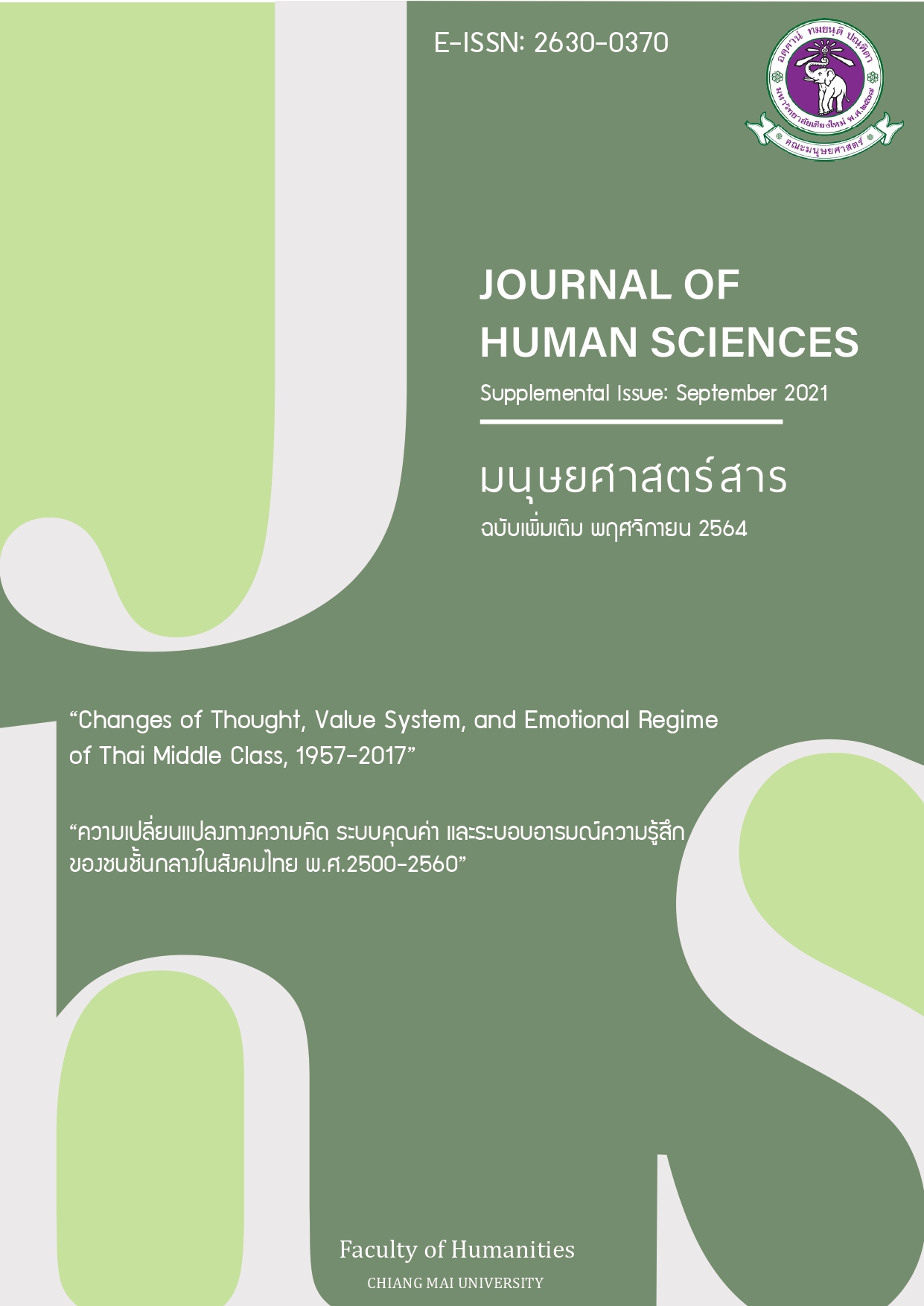“อุดมการณ์ราชาชาตินิยม” ในสังคมมุสลิมไทย จากรัฐสมบูรณาญาสิทธิราชย์ ถึง พ.ศ.2519
Main Article Content
บทคัดย่อ
อุดมการณ์ราชาชาตินิยม มีพลวัตที่มีลักษณะยืดหยุ่นยาวนานมากพอที่จะส่งผลให้กลุ่มทางสังคมอันหลากหลายสามารถที่จะปรับเปลี่ยน รวมถึงสร้างสรรค์ให้สอดคล้องกับรากฐานทางความเชื่อของสังคม
นั้นๆ ได้ สังคมมุสลิมไทยก็ได้รับเอาแนวคิดดังกล่าวเข้ามาปรับเปลี่ยนเพื่อให้เข้ากับ “ความเป็นมุสลิม” ในประวัติศาสตร์เช่นเดียวกัน
สังคมมุสลิมไทยได้เริ่มพัฒนาระบบความคิดให้กลมกลืนกับโครงการขัดเกลาทางสังคมของกลุ่มชนชั้นนำไทยมานับตั้งแต่ยุคของรัฐสมบูรณาญาสิทธิราชย์ ชนชั้นนำยอมรับแนวคิด “พระบรมราชูปถัมภ์”
ไปพร้อมกับการสร้างให้ “ราชาชาตินิยม” เป็นอุดมคติที่สัมพันธ์กับความเป็นมุสลิมในสังคมไทย พระบาทสมเด็จพระมงกุฎเกล้าเจ้าอยู่หัว ได้ทรงทำให้อุดมการณ์ราชาชาตินิยมสัมพันธ์กับมุสลิมผ่าน
“พระบรมราชูปถัมภ์” โดยเน้นให้มุสลิมตอบแทนด้วยการเสียสละเพื่อชาติ ศาสนา พระมหากษัตริย์ พร้อมกันนั้น หลักการของศาสนาอิสลามก็ได้ถูกตีความให้สอดคล้องกับแนวทางดังกล่าวด้วยเช่นกัน
ในช่วงต้นรัชกาลที่ 9 บทบาทของการเป็นผู้อุปถัมภ์ศาสนาของพระองค์แสดงออกผ่านการสนับสนุน “เสรีภาพทางศาสนา” อย่างเปิดเผย เพื่อตอบสนองบริบทของการเมืองในเวลานั้น อุดมการณ์ราชาชาตินิยมถูกตีความผ่านหลักการศาสนาอีกครั้งในนามของเสรีภาพ กอปรกับการอ้างความชอบธรรมจากการปกครองในระบอบประชาธิปไตย สัญลักษณ์ของความเป็นมุสลิมในช่วงนี้ ให้ความสำคัญไปที่การสร้างความมั่นคงให้แก่ชาติ ศาสนา และพระมหากษัตริย์ อันเป็นสถาบันที่จะรับประกันสิทธิในการนับถือศาสนาเพื่อสกัดการไหลบ่าของกระแสความคิดสังคมนิยม
Article Details
เอกสารอ้างอิง
Banchi rai nam toimam thi dai rap phraratchathan phasa rong krap læ sưa yot pen huana khana nai wan maha mongkhon samai chalœm phra chon phansa Phutthasakkarat 2459 [The List of Imams Who Received Prayer Rug and Ranked Apparel on The Ocassion of King's Birthday]. (1916, 14 January-c). Government Gazette. lem 33 ton thi ngo. na 2825.
Chiwit læ ngan khong nai tuan suwan sa [Life and Contributions of Mr. Tuan Suvannasat]. (1982). Bangkok: Munnithi tuan suwan sa chularatchamontri.
Chonlaworn, P. (2013). Kan padirup kotmai læ kan san nai Pattani samai chet huamưang [Reformation of "Law" and "Jurisdiction" in Pattani during Seven Mandated-Melayu Provinces]. RUSAMILAE JOURNAL, 34(4). 8-30.
Chuenpakdee, S. (2001). Mutsalim matsayit ton son kap bap chon sam yuk samai : prawat chao matsayit ton son bot wikhro khwampenma siro̜i pi khiang khu ekkaratchachat Thai [Islamic Committee of Masjid Tonson and The 3-Eras-Forebears: Masjid Tonson and the 400 Years of History of Thai-Independent-Nation] . Bangkok: Khana kammakan chat ngan sewana Mutsalim matsayit ton son kap bap chon sam yuk samai.
Jeamteerasakul, S. (2001). Prawattisat thi phœng sang [The Reconstructed History]. Bangkok: Samnakphim hok tula ramlưk.
Kham krap thawai bangkhom thunklao thunkramom thawai dokmai thup thian lækhatha a den Itsalam [The Informed Script to the Royal-Highness regarding Islamic Tribute (Dokmai thup thian and Khatha a den Itsalam)]. (1916, 14 January-a). Government Gazette. lem 33 ton thi ngo. na 2819.
Lona, A. (2014). Phatthanakan kan khian prawattisat Itsalam nai sangkhom Thai ( yuk rat charit - Pho.So. 2511) [The Development of Writing on Islamic History in Thai society (The age of pre-nation state - 1968 C.E.)]. (Master of Arts (History), Thammasat University), Retrieved from https://digital.library.tu.ac.th/tu_dc/frontend/Info/item/dc:104628#
Mukem, E. (2016). RAJA KITA : Sathaban kasat kap mao lit klang hæng prathet Thai [Royal Institution and Thailand's Mawlid un-Nabi]. Retrieved from http://www.thealami.com/main/content.php?page=sub&category=5&id=1864&fbclid=IwAR2TVE5Z1I7bHEXOVeYnyx3mn6Aj-5JnjeGQAeY4xqYmoNvd5D4YQ2lVSTg
Phra rat chakritsadika waduai kan satsanupatham fai Itsalam [Islamic-Patronage Decree (1945)]. (1945, 8 May). Government Gazette. lem 62 ton thi 66 ko. na 332.
Phra rat chakritsadika waduai kan satsanupatham fai Itsalam (chabap thi 2) Pho.So. 2491 [Islamic-Patronage Decree (Volume 2) (1948)]. (1948, 31 December). Government Gazette. lem 65 ton thi 77 ko na 4
Phra rat damrat top Itsalam satsanik borisat [Royal-Answer to Islamic Committee]. (1915, 16 January). Government Gazette. lem 32 ton thi ngo. na 2509.
Phra rat damrat top phuak khæk Itsalam fao thawai chai mongkhon wan thi 31 Thanwakhom Phutthasakkarat 2459 [The Royal-Answer to The Islamic Tribute on 31st December 1916]. (1916, 14 January-b). Government Gazette. lem 33 ton thi ngo. na 2823.
Phuminarong, S. (1976). Satsana Itsalam son arai : chabap khong samnak chularatchamontri [What Does Islam Teach?: A Chularatchamontri (Shaykh al-Islam in Thailand ) Official Edition]. Bangkok: Department of Religious Affairs.
Sathaban phra maha kasat kap Mutsalim nai phændin Thai [The Monarchy and Muslims in Thailand]. (2013). (S. Chutintaranond Ed.). Bangkok: Institute of Asian Studies Chulalongkorn University.
Sattayanurak, S. (2014). Sip panyachon Sayam lem 1 panyachon hæng ratsomburanyasitthirat [10 Saimese Intellectuals Vol. 1, Intellectuals of Absolute Monarchy]. Bangkok: openbooks.
Scupin, R. (1980). The Politics of Islamic Reformism in Thailand. Asian Survey, 20(12). 1223-1235. doi:10.2307/2643628
Scupin, R. (1981). The socio‐economic status of Muslims in central and North Thailand. Institute of Muslim Minority Affairs Journal, III(2). 162-190. doi:10.1080/02666958108715845
Suasaming, A. (2009). Phak phanuak : 3. kan siachiwit bæp chahit (morana sakkhi) [Appendix: 3. Shahid (Martyr in Islam)]. Retrieved from https://alisuasaming.org/main/appendix-sahid/
Suasaming, A. (2016). Khwammai nưarong botphleng sanrasœn phra barami phak phasa Arap thang 2 samnuan [Interpretation of Thai Royal Anthem, Comparing with 2 Arabic-Translated Styles ]. Retrieved from https://alisuasaming.org/main/?p=6859
Ungamsin, S. (2018). Chularatchamontri tuan suwan sa : chiwit læ bæpyang kan yu ruam kan yang samanachan nai sangkhom phahu watthanatham [Shaykul al-Islam Tuan Suvannasat: Life and Examplars of Peaceful Living on Multicultural Society]. RUSAMILAE JOURNAL, 39(2). 83-94. Retrieved from https://so05.tci-thaijo.org/index.php/rusamelae/article/view/145668
Vajiravudh, H. M. K. (1914). Thetsana sưapa kan thi nưng thưng sipet ruam kan phiset duai [Edifying Sưapa (Wild Tiger Corps) Chapter 1 - 11 (Extra Chapter included)]. Retrieved from https://digital.library.tu.ac.th/tu_dc/frontend/Info/item/dc:48185
Vajiravudh, H. M. K. (1941). Plukchai sưapa [Arousing Sưapa (Wild Tiger Corps)]. Phra Nakhon: Rongphim amnuai sin.
Winichakul, T. (2016). Chomna racha chatniyom: waduai prawattisat Thai [The Actual Characteristic of Royal-Nationalism in Thai History]. Nonthaburi: Fa diaokan.
YUSUF, I. (1998). ISLAM AND DEMOCRACY IN THAILAND: REFORMING THE OFFICE OF "CHULARAJMONTRI/SHAIKH AL-ISLAM". Journal of Islamic Studies, 9(2). 277-298. Retrieved from http://www.jstor.org/stable/26198065


